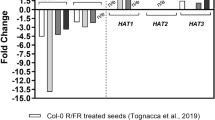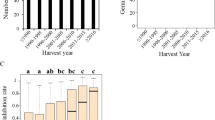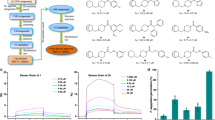Abstract
IT has been previously reported1 that the dispersal units of Aegilops ovata L. contain a germination inhibitor. Leachates of the hulls inhibited the germination of Lactuca achenes. This inhibition was considerably stronger in light than in darkness, an unusual feature, since all germination inhibitors already described inhibit the germination of Lactuca achenes in darkness more than in light. We therefore felt it essential to isolate and characterise this specific inhibitor present in Aegilops ovata.
This is a preview of subscription content, access via your institution
Access options
Subscribe to this journal
Receive 51 print issues and online access
$199.00 per year
only $3.90 per issue
Buy this article
- Purchase on SpringerLink
- Instant access to full article PDF
Prices may be subject to local taxes which are calculated during checkout
Similar content being viewed by others
References
Datta, S. C., Evenari, M., and Gutterman, Y., Israel J. Bot., 19, 463–483 (1970).
Freudenberg, K., and Weinges, K., Tetrahedron, 15, 115 (1961).
Nakanishi, K., in Infrared Absorption Spectroscopy, 44, (Holden-Day, New York, 1964).
Author information
Authors and Affiliations
Rights and permissions
About this article
Cite this article
LAVIE, D., LEVY, E., COHEN, A. et al. New germination inhibitor from Aegilops ovata L.. Nature 249, 388 (1974). https://doi.org/10.1038/249388a0
Received:
Issue date:
DOI: https://doi.org/10.1038/249388a0
This article is cited by
-
QTLs for uniform grain dimensions and germination selected during wheat domestication are co-located on chromosome 4B
Theoretical and Applied Genetics (2016)
-
The seasonal variations of allelopathic activity and allelopathic substances in Brachiaria brizantha
Botanical Studies (2015)
-
Lignan and flavonoids from the stems of Zea mays and their anti-inflammatory and neuroprotective activities
Archives of Pharmacal Research (2015)
-
Strategies of seed dispersal and germination in plants inhabiting deserts
The Botanical Review (1994)
-
Germination inhibition activity of a naturally occurring lignan fromAegilops ovata L. in green and infrared light
Experientia (1980)



